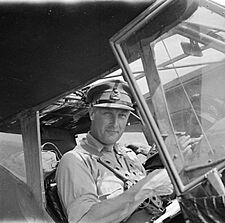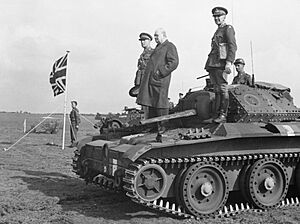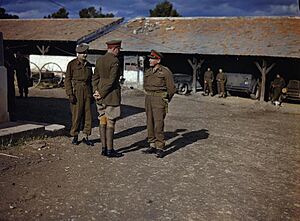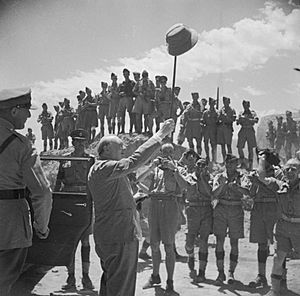Kenneth Anderson (British Army officer) facts for kids
Quick facts for kids
Sir Kenneth Anderson
|
|
|---|---|

Anderson in 1943
|
|
| Nickname(s) | "Sunshine" |
| Born | 25 December 1891 Madras, British India |
| Died | 29 April 1959 (aged 67) King George V Hospital, Gibraltar |
| Buried |
North Front Cemetery, Gibraltar
|
| Allegiance | United Kingdom |
| Service/ |
British Army |
| Years of service | 1911–1952 |
| Rank | General |
| Service number | 12023 |
| Unit | Seaforth Highlanders |
| Commands held | East Africa Command (1945–46) Eastern Command (1942, 1944) Second Army (1943–44) First Army (1942–43) II Corps (1941–42) VIII Corps (1941) 1st Infantry Division (1940–41) 11th Infantry Brigade (1938–40) 152nd (Seaforth and Cameron Highlanders) Infantry Brigade 2nd Battalion, Seaforth Highlanders |
| Battles/wars | First World War North West Frontier Second World War |
| Awards | Knight Commander of the Order of the Bath Military Cross Mentioned in Despatches (2) Knight of the Order of St John Chief Commander of the Legion of Merit (United States) Commander of the Legion of Honour (France) Croix de guerre (France) Grand Cross of the Order of Ouissam Alaouite (Morocco) Grand Cordon of the Order of Glory (Tunisia) Grand Cross of the Order of the Star of Ethiopia |
General Sir Kenneth Arthur Noel Anderson (born 25 December 1891 – died 29 April 1959) was an important British Army officer. He served in both world wars. He is best known for leading the British First Army during Operation Torch. This was the Allied invasion of North Africa. He also led them during the Tunisian campaign. This campaign ended with the capture of nearly 250,000 Axis soldiers.
Kenneth Anderson was a quiet person. He did not try to be popular with his leaders or the public. His American commander, General Dwight D. Eisenhower, said he was "blunt, at times to the point of rudeness." Because of this, he is not as famous as some other generals from his time. However, many historians agree he handled a difficult campaign well.
Contents
Early Life and First World War Service
Kenneth Arthur Noel Anderson was born on Christmas Day, 25 December 1891. He was born in Madras, which was then part of British India. His father, Arthur Robert Anderson, was a Scottish railway engineer.
He went to school in England at Charterhouse School. Then he attended the Royal Military College, Sandhurst. On 19 September 1911, he became a second lieutenant in the Seaforth Highlanders. This was a famous British Army regiment. He joined the 1st Battalion in British India. He was promoted to lieutenant on 29 November 1913.
When the First World War began in August 1914, Anderson's battalion was still in India. They were sent to the Western Front in France. They arrived there in late September 1914. He stayed with his battalion through many battles. He became an acting captain on 10 April 1915, and a full captain on 1 October 1915.
From December 1915 to July 1916, he served as an adjutant for another battalion. He received the Military Cross (MC) for his bravery. He was wounded during the Battle of the Somme on 1 July 1916. This was the first day of the battle. His battalion suffered many casualties that day. The award for his bravery said:
For conspicuous gallantry. Captain Anderson was severely wounded in front of an enemy first line trench. He endeavoured to struggle on, but progress was impossible as one of his legs was broken. Nevertheless, although exposed to heavy fire, he continued to direct and encourage his men.
It took him 18 months to recover from his injuries. He rejoined the 1st Battalion, Seaforths, in Palestine. He was promoted to acting major on 12 May 1918. He returned to the rank of captain in July 1919.
On 12 February 1918, Anderson married Kathleen Lorna May Gamble. They had two children, Michael Iain Anderson and a daughter.
Between the World Wars
Anderson continued his military career between the two world wars. He served as an adjutant for the Scottish Horse from 1920 to 1924. During this time, he was promoted to major. He attended the Staff College, Quetta from 1927 to 1928.
After Staff College, Anderson became a staff officer (GSO2) in the 50th (Northumbrian) Division. This was a Territorial Army (TA) unit. In 1930, he was promoted to lieutenant colonel. He became the Commanding Officer (CO) of the 2nd Battalion, Seaforths, in the North West Frontier. He was mentioned in official reports for his service there.
Back in Scotland, he became a full colonel. In August 1934, he took command of the 152nd (Seaforth and Cameron) Infantry Brigade. This was part of the 51st (Highland) Infantry Division, another TA unit. In March 1936, he took a staff job in India. In January 1938, he became an acting brigadier. He commanded the 11th Infantry Brigade. This brigade was part of the 4th Infantry Division. He trained his brigade hard, even though they did not have all the best equipment.
Second World War Service
France and Belgium Campaigns
Soon after the Second World War began in September 1939, Anderson led the 11th Brigade to France. It was part of the British Expeditionary Force (BEF). Anderson served with the BEF during the "Phoney War" and the Battle of France in May 1940.
During the evacuation from France, Major-General Bernard Montgomery was promoted. He had been leading the 3rd Infantry Division. Lieutenant-General Sir Alan Brooke, who was leaving his command, chose Anderson to temporarily lead Montgomery's 3rd Division. Brooke thought highly of Anderson.
Defending the United Kingdom

After returning to the United Kingdom from Dunkirk, Anderson briefly went back to his 11th Brigade. On 13 June, he was promoted to acting major-general. He became the commander of the 1st Infantry Division. This division had fought in France. His rank of major-general became permanent on 17 June 1940. The division's job was to defend the coast of Lincolnshire from a possible German invasion. On 11 July, he was made a Companion of the Order of the Bath. On 26 July 1940, he was mentioned in official reports for his service in France and Belgium.
On 18 May 1941, Anderson left the 1st Division. He was promoted to acting lieutenant-general. He was given command of VIII Corps. He led this corps until December. Then he took command of II Corps. His time with II Corps was short. In April 1942, he was promoted to General Officer Commanding-in-Chief (GOC-in-C) of Eastern Command.
In August 1942, Anderson was given command of the First Army. This happened even though he had little experience leading such large forces in battle. The First Army was preparing for Operation Torch. This was the Allied invasion of French North Africa. Several other generals were considered for the role, but due to various reasons, Anderson was chosen. The Chief of the Imperial General Staff, General Sir Alan Brooke, knew Anderson well. He believed Anderson was capable of this important job.
North Africa Campaigns
The Torch landings happened in early November 1942. Anderson wanted to quickly advance from Algeria into Tunisia. He wanted to stop the Axis from taking over Tunisia. His force was not very strong at this point. In late 1942, they tried a "Run for Tunis". They aimed to capture Tunis before the Axis could build up their forces. The attempt failed, and his troops were pushed back.
As more Allied forces arrived, they struggled with working together. In January 1943, General Dwight D. Eisenhower, the American Supreme Allied Commander, convinced the French to put their XIX Corps under Anderson's First Army. Anderson also became responsible for the American troops, especially the U.S. II Corps. This corps was led by Major General Lloyd Fredendall.
Controlling these forces was hard. They were spread over 200 miles, and communication was poor. Anderson and Fredendall did not always work well together. Soldiers sometimes received confusing orders. Anderson was concerned about Fredendall's leadership but did not openly protest.
The U.S. II Corps later suffered a big defeat at the Battle of Kasserine Pass. German Field Marshal Erwin Rommel attacked Allied forces there. While Fredendall received most of the blame, some British and Allied commanders also questioned Anderson's leadership. For example, Anderson allowed a request for support for the French XIX Corps to go unfulfilled. He also refused Fredendall's request to move to a safer line after the first attack. This allowed German forces to overrun American positions.
As more Allied and Axis forces gathered in Tunisia, the 18th Army Group HQ was formed in February 1943. General Sir Harold Alexander led it. Alexander thought about replacing Anderson. However, he decided not to change commanders at such a critical stage. Anderson managed to keep his position. He performed well after V Corps held off the last Axis attack during Operation Ochsenkopf.
In May 1943, Allied forces won a great victory. The Axis forces surrendered unconditionally. About 125,000 German soldiers were captured. General Eisenhower, Anderson's superior, later praised him. He said Anderson was "a gallant Scot, devoted to duty and absolutely selfless." He also noted Anderson's "fighting heart" and the "smashing victory he finally attained in Tunisia."
Anderson was the first person to receive the American Legion of Merit in the Chief Commander grade. He received it on 18 June 1943, for his service in North Africa. After the First Army was disbanded, Anderson returned to Britain in July. He was given command of the British Second Army. This army was preparing for Operation Overlord, the Allied invasion of Normandy. Anderson's rank of lieutenant-general became permanent in July. He was also made a Knight Commander of the Order of the Bath (KCB) in August.
However, some commanders, like Alexander and Montgomery, still had criticisms. In January 1944, Montgomery took command of the 21st Army Group. Anderson was replaced by Lieutenant-General Miles Dempsey. This was seen as a demotion for Anderson. He was given Eastern Command, a job he had held before. His time as a field commander in major battles was over. His last military job was as GOC-in-C of East Africa Command.
After the War
After the war, Sir Kenneth Anderson became the military commander and Governor of Gibraltar. He helped build new houses to improve living conditions there. He also helped bring about constitutional changes, creating a Legislative Council. He was promoted to full general in July 1949. He retired in June 1952 and lived mostly in the south of France.
His later years were sad. His only son, Michael, who was a lieutenant in the Seaforth Highlanders, died in action in Malaya in 1949, at age 22. His daughter also died after a long illness. Sir Kenneth Anderson himself died of pneumonia in Gibraltar on 29 April 1959, at the age of 67.
Images for kids







